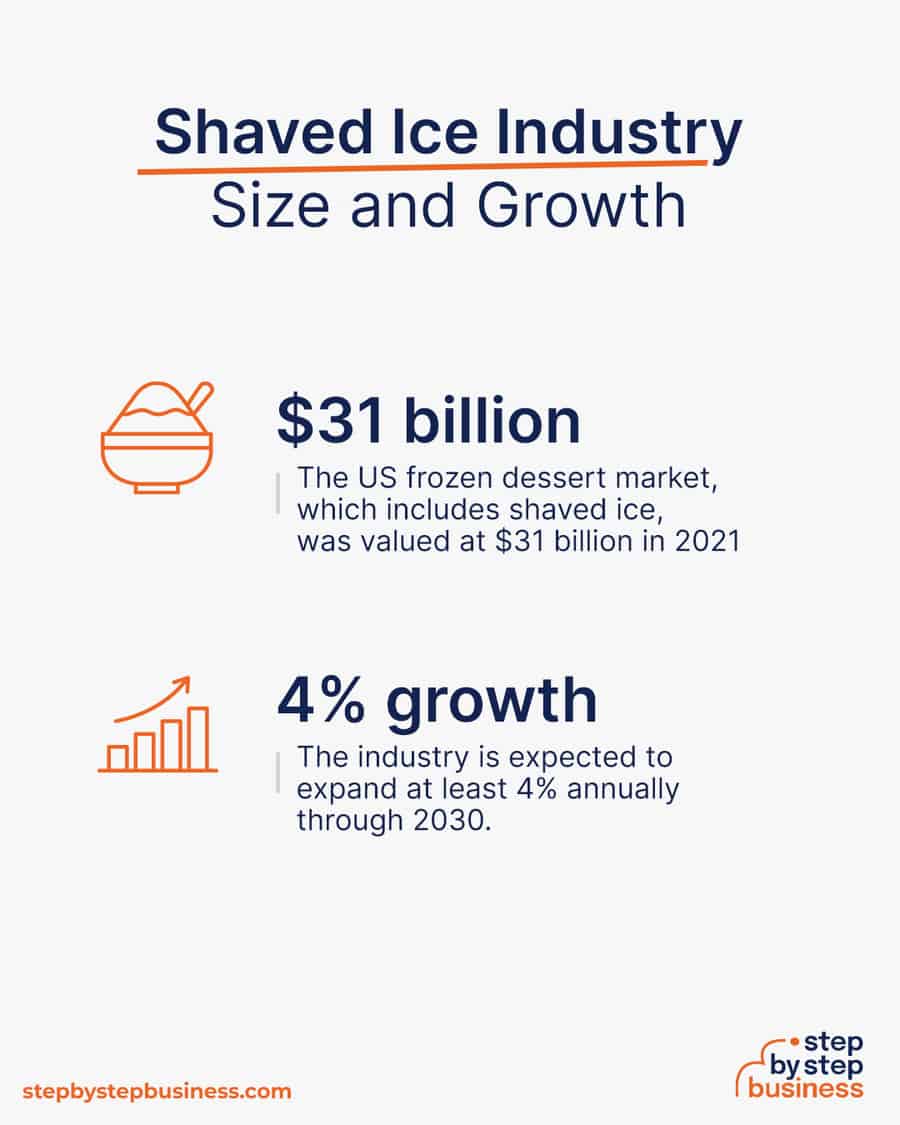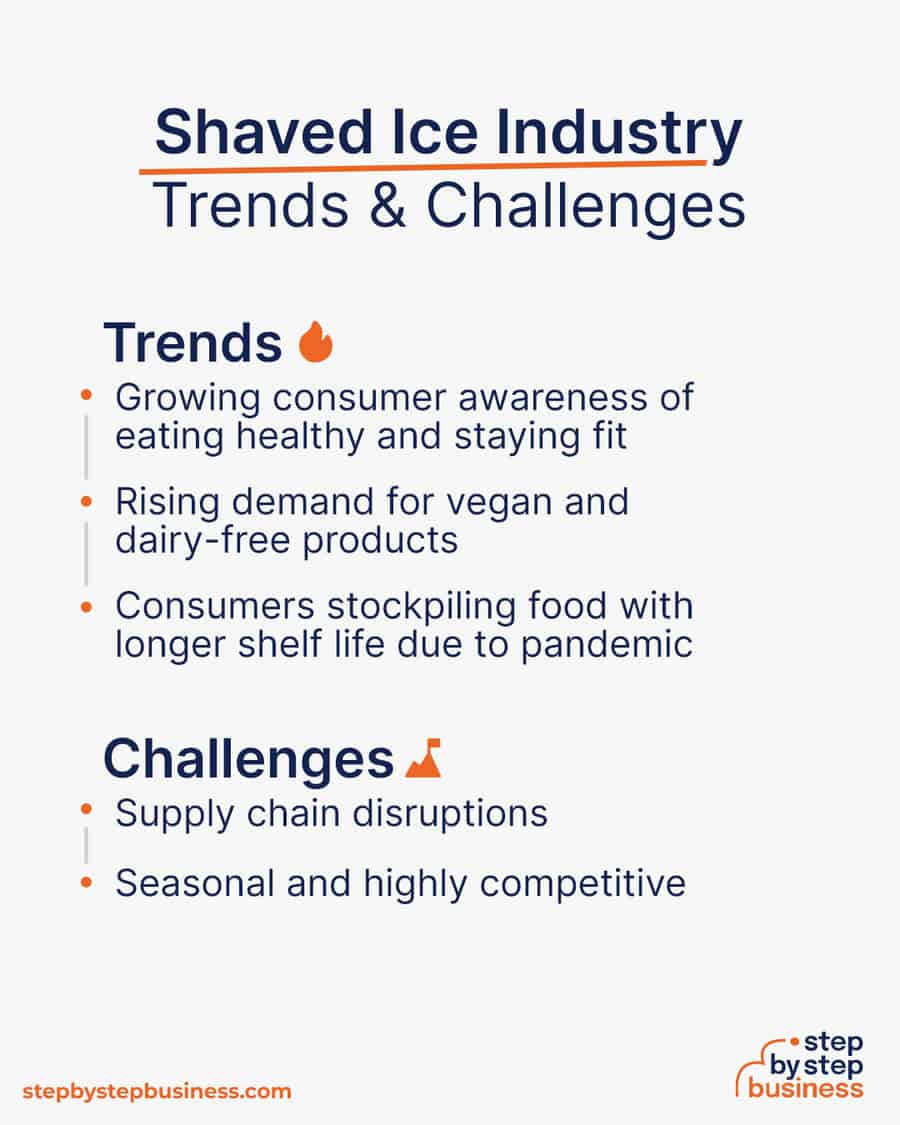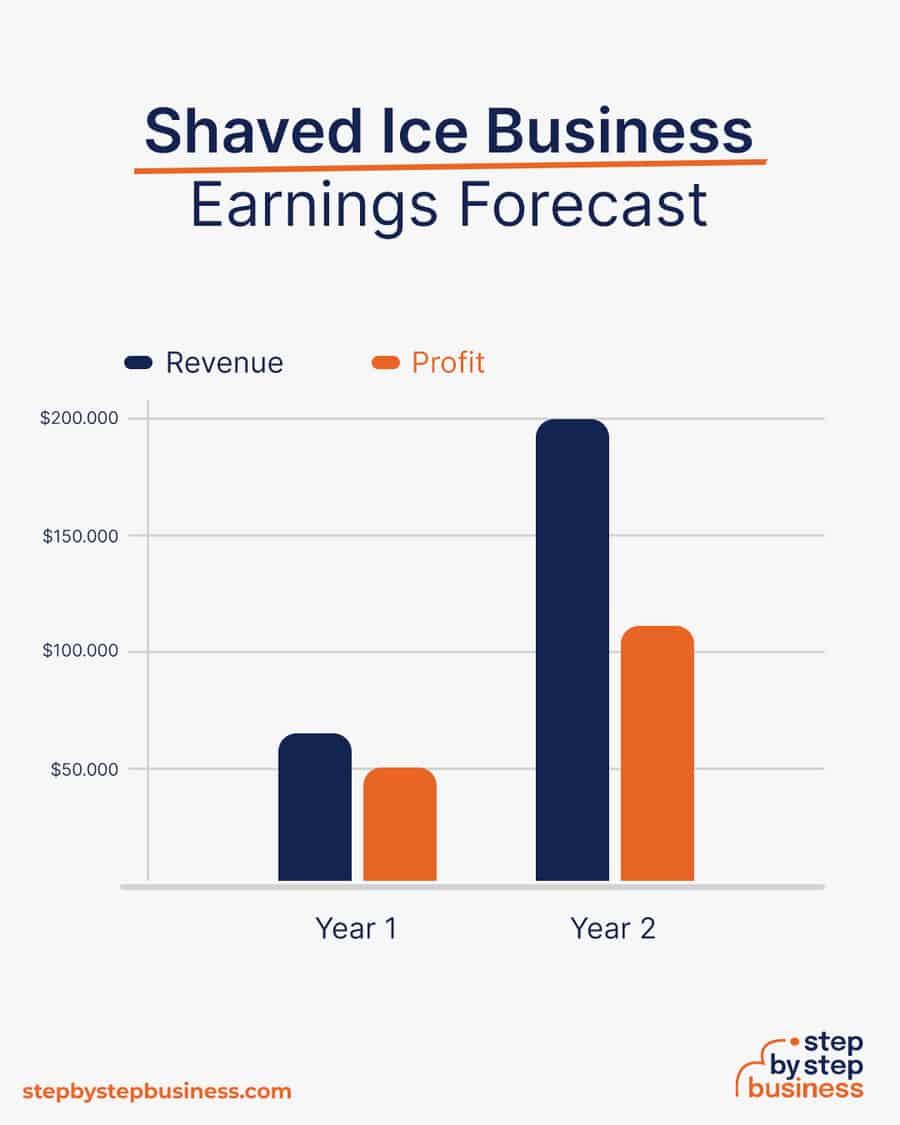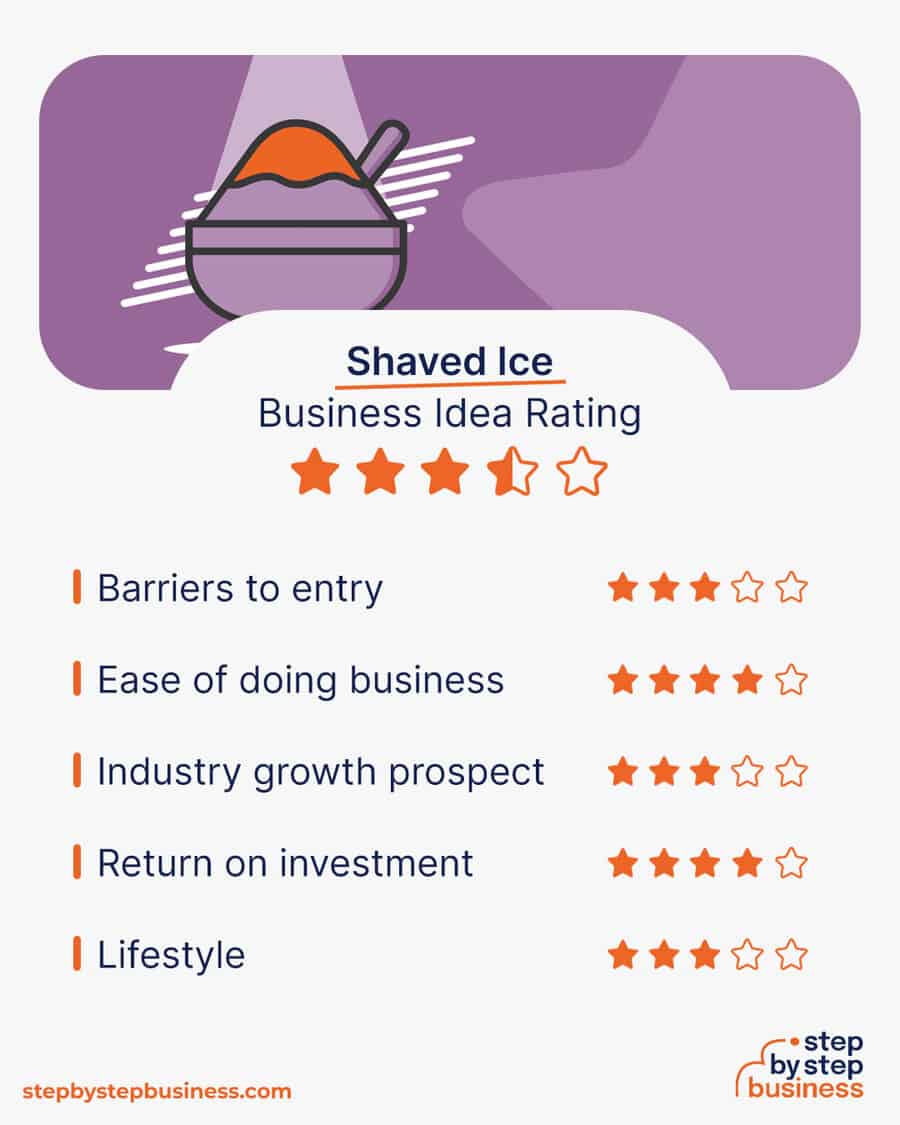On a hot summer day, shaved ice can be the very definition of refreshing! So why not live out those summertime dreams and start up your own shaved ice business?
The market for shaved ice, or snow cones, is expected to grow steadily in the coming years, offering real opportunity for the smart entrepreneur. The business tends to be seasonable, but you’ll be able to spend your time outdoors, in parks and at special gatherings, enjoying life with locals as you make good money.
You can start out as a solopreneur with a single cart, then scale up to a shaved ice shop or dozens of carts across the city. Of course, starting any business is a challenge that requires hard work and determination. Thankfully, you’ve come to the right place, as this step-by-step guide lays out all you need to know to develop and launch your promising shaved ice business.
Let’s start at the beginning.
Step 1: Decide if the Business Is Right for You
It’s crucial to consider the factors that go into starting a business and decide if it’s right for you. Unfortunately, loving shaved ice is not enough to be successful in the business! Read through the below before taking the leap.
Starting a business is going to have both pros and cons. It’s important to review them before jumping into a new business venture.
Pros
- Getting started is easy, inexpensive
- Flexible hours
- No experience required
- Follow demand to a variety of outdoor spaces and events
- Make people happy with a tasty dessert!
Cons
- Demand tends to be seasonal, depending on your location
- Saturated market with significant competition
- Repetitive, sometimes tedious and strenuous work
Shaved ice industry trends
The shaved ice and snow cone market grew steadily from 2014 to 2019, according to industry analyst Market Research Explore. Following a pandemic-driven downturn in outdoor events, frozen desserts like shaved ice started coming back strong in 2021.
Industry size and growth
Trends and challenges
Trends shaping the shaved ice industry include:
- Growing consumer awareness of eating healthy and staying fit
- Rising demand for vegan and dairy-free products
- Consumers stockpiling food with longer shelf life due to pandemic
Challenges in the shaved ice industry include:
- Supply chain disruptions
- Seasonal and highly competitive
How much does it cost to start a shaved ice business?
Startup costs for a shaved ice business are fairly low, assuming you launch your business with a single mobile cart. The minimum start-up total is about $7,500, while the high-end cost, which includes a storefront and mobile vending trailer, is about $28,000.
You’ll need a handful of items to successfully launch your shaved ice business. Here’s a list to get you started:
- Ice maker and mobile cart
- Cube/block ice shaver
- Flavored syrups, cups, spoons, straws, napkins
- Tablet Device and point-of-sale software
- Computers and IT equipment
| Start-up Costs | Ballpark Range | Average |
| Licenses, permits, and insurance | $550 - $1,100 | $825 |
| Shaved ice equipment and supplies | $3,300 - $8,950 | $6,125 |
| IT device, equipment, and software | $500 - $2,500 | $1,500 |
| Shop furniture, decor, and lighting | $0 - $1,750 | $875 |
| Branding, marketing, and advertising | $1,000 - $5,000 | $3,000 |
| Website | $100 - $1,000 | $550 |
| Paper and stationery | $50 - $100 | $75 |
| Hiring | $0 - $100 | $50 |
| Cart | $2,000 - $0 | $1,000 |
| Vending trailer | $0 - $7,500 | $3,750 |
| Total | $7,500 - $28,000 | $17,750 |
How much can you earn from a shaved ice business?
Because demand fluctuates with the seasons, monthly revenue for a single cart shaved ice business can run from $200 to more than $10,000. From October to March, you may want to consider shifting to a cold-weather alternative, like hot tea, though some owners shut down for the winter and re-open again as the weather warms up.
In your first couple of years, you might generate enough sales to average $5,000 in monthly revenue, which would give you just over $60,000 for the year. This would give you a pre-tax profit of $50,000, assuming an 80% margin.
With your own shop, revenues will be significantly higher, but the increased overhead will bring your margin down to 55%. You might be able to generate $200,000 in annual revenue, which would give you a tidy profit of $110,000.
Within five years you could scale the business to three storefronts and five carts, generating close to $1 million in revenue and nearly half that in profit.
What barriers to entry are there?
After looking at the financials, you can see that there is good revenue potential in the shaved ice business. But there are some barriers to entry to consider before getting started, such as:
- Strict regulations around the safe processing and handling of food products
- High competition from many small-scale operators in shaved ice business and ice cream
- Difficult to build brand loyalty due to the mobile nature of business
- DIY shaved ice machines exist and people may opt to make their own at home
- Seasonality means less consistent income
Related Business Ideas
If you’re still not sure whether this business idea is the right choice for you, here are some related business opportunities to help you on your path to entrepreneurial success.
Step 2: Hone Your Idea
Why? Identify an opportunity
All businesses need to find clients to start making money. That means you need to determine where the demand is for your product. Overall, the frozen dessert industry is very popular, because people love dessert!
However, the demand for shaved ice will primarily be driven by rising demand for low-calories and low-sugar desserts in the US. Consumers are eager to try new options that do not have a negative impact on their health.
Shaved ice is also an excellent alternative for vegans or others who avoid dairy but still want a delicious frozen treat. This is a growing market and is a good segment to market your business towards. Shaved ice also has hundreds of flavors, so your business will have something for every taste of the customer.
What? Determine your products or services
The main ingredients for shaved ice are ice shavings and flavored syrups. Each vendor gains popularity based on their top flavors and customer service. You can purchase flavors in powders, concentrates, and ready-to-use syrups from a supplier such as Snowie.
Shaved ice is usually served in a paper cup or cone with a spoon or straw, though customers can also just eat it directly like an ice cream cone.
There are a few different ways you can sell your shaved ice. The following options vary in mobility and will affect the number of people you can serve. Here are your options:
- Cart — on wheels and mobile, can be rolled up onto a sidewalk, a park, or even the beach
- Kiosk — a small storefront placed on a street with high foot traffic
- Storefront — a traditional brick-and-mortar store that can serve a high volume of customers at one time
- Vending trailer — similar to but larger than a cart, allows for greater sales volume
How much should you charge for shaved ice?
Prices start at around a dollar per 8-ounce cup and go as high as $5 per cup in a pricey district during peak-demand summer months. Research local competitors to check out their offerings and prices, and customer response. Perhaps you could offer a slightly smaller cup at a better price? Or go big with a 12-ounce cup.
Once you know your costs, you can use this Step By Step profit margin calculator to determine your mark-up and final price points. Remember, the prices you use at launch should be subject to change if warranted by the market.
Who? Identify your target market
It’s important to identify your target market for your shaved ice business. Here are a few examples of market segments that you can target and promote your product to:
- Families with kids: Kids love sweet treats! Therefore, targeting families and going to where they spend time (i.e. parks, beaches) can be a great way to drive sales.
- Vegans and others avoiding dairy: Since shaved ice does not include dairy, it’s a great alternative for those who are allergic or avoid dairy for ethical reasons. Think cultural events like music and arts festivals.
Where? Choose your business premises
In the early stages, you may want to run your business from home to keep costs low. But as your business grows, you’ll likely need to hire workers for various roles and may need to rent out a storefront. You can find commercial space to rent in your area on sites such as Craigslist, Crexi, and Instant Offices.
When choosing a commercial space, you may want to follow these rules of thumb:
- Central location accessible via public transport
- Ventilated and spacious, with good natural light
- Flexible lease that can be extended as your business grows
- Ready-to-use space with no major renovations or repairs needed
You’d also want to go where the demand is. Just think – when do people have a craving for a frozen dessert? With that logic, the best locations to sell shaved ice are sporting events such as baseball and soccer fields, basketball courts; beaches, parks, and other outdoor recreation areas; fairs, festivals, carnivals and other local events; and birthdays, fundraisers, corporate events, weddings, church events.
Step 3: Brainstorm a Business Name
Your business name is your business identity, so choose one that encapsulates your objectives, services, and mission in just a few words. You probably want a name that’s short and easy to remember, since much of your business, and your initial business in particular, will come from word-of-mouth referrals.
Here are some ideas for brainstorming your business name:
- Short, unique, and catchy names tend to stand out
- Names that are easy to say and spell tend to do better
- The name should be relevant to your product or service offerings
- Ask around — family, friends, colleagues, social media — for suggestions
- Including keywords, such as “shaved ice” or “snow cone”, boosts SEO
- Choose a name that allows for expansion: “Jim’s Bakery” over “Jim’s Cookies”
- Avoid location-based names that might hinder future expansion
- Use online tools like the Step by Step business name generator. Just type in a few keywords and hit “generate” and you’ll have dozens of suggestions at your fingertips.
Once you’ve got a list of potential names, visit the website of the US Patent and Trademark Office to make sure they are available for registration and check the availability of related domain names using our Domain Name Search tool. Using “.com” or “.org” sharply increases credibility, so it’s best to focus on these.
Finally, make your choice among the names that pass this screening and go ahead with domain registration and social media account creation. Your business name is one of the key differentiators that sets your business apart. Once you pick your company name, and start with the branding, it is hard to change the business name. Therefore, it’s important to carefully consider your choice before you start a business entity.
Step 4: Create a Business Plan
Every business needs a plan. This will function as a guidebook to take your startup through the launch process and maintain focus on your key goals. A business plan also enables potential partners and investors to better understand your company and its vision:
- Executive Summary: Brief overview of the entire business plan; should be written after the plan is complete.
- Business Overview: Overview of the company, vision, mission, ownership, and corporate goals.
- Product and Services: Describe your offerings in detail.
- Market Analysis: Assess market trends such as variations in demand and prospects for growth, and do a SWOT analysis.
- Competitive Analysis: Analyze main competitors, assess their strengths and weaknesses, and create a list of the advantages of your services.
- Sales and Marketing: Examine your companies’ unique selling propositions (USPs) and develop sales, marketing, and promotional strategies.
- Management Team: Overview of management team, detailing their roles and professional background, along with a corporate hierarchy.
- Operations Plan: Your company’s operational plan includes procurement, office location, key assets and equipment, and other logistical details.
- Financial Plan: Three years of financial planning, including startup costs, break-even analysis, profit and loss estimates, cash flow, and balance sheet.
- Appendix: Include any additional financial or business-related documents.
If you’ve never created a business plan, it can be an intimidating task. You might consider hiring a business plan specialist at Fiverr to create a top-notch business plan for you.
Step 5: Register Your Business
Registering your business is an absolutely crucial step — it’s the prerequisite to paying taxes, raising capital, opening a bank account, and other guideposts on the road to getting a business up and running.
Plus, registration is exciting because it makes the entire process official. Once it’s complete, you’ll have your own business!
Choose where to register your company
Your business location is important because it can affect taxes, legal requirements, and revenue. Most people will register their business in the state where they live, but if you are planning to expand, you might consider looking elsewhere, as some states could offer real advantages when it comes to shaved ice.
If you’re willing to move, you could really maximize your business! Keep in mind, it’s relatively easy to transfer your business to another state.
Choose your business structure
Business entities come in several varieties, each with its pros and cons. The legal structure you choose for your shaved ice business will shape your taxes, personal liability, and business registration requirements, so choose wisely.
Here are the main options:
- Sole Proprietorship – The most common structure for small businesses makes no legal distinction between company and owner. All income goes to the owner, who’s also liable for any debts, losses, or liabilities incurred by the business. The owner pays taxes on business income on his or her personal tax return.
- General Partnership – Similar to a sole proprietorship, but for two or more people. Again, owners keep the profits and are liable for losses. The partners pay taxes on their share of business income on their personal tax returns.
- Limited Liability Company (LLC) – Combines the characteristics of corporations with those of sole proprietorships or partnerships. Again, the owners are not personally liable for debts.
- C Corp – Under this structure, the business is a distinct legal entity and the owner or owners are not personally liable for its debts. Owners take profits through shareholder dividends, rather than directly. The corporation pays taxes, and owners pay taxes on their dividends, which is sometimes referred to as double taxation.
- S Corp – An S-Corporation refers to the tax classification of the business but is not a business entity. An S-Corp can be either a corporation or an LLC, which just need to elect to be an S-Corp for tax status. In an S-Corp, income is passed through directly to shareholders, who pay taxes on their share of business income on their personal tax returns.
We recommend that new business owners choose LLC as it offers liability protection and pass-through taxation while being simpler to form than a corporation. You can form an LLC in as little as five minutes using ZenBusiness’s online LLC formation service. They will check that your business name is available before filing, submit your articles of organization, and answer any questions you might have.
Step 6: Register for Taxes
The final step before you’re able to pay taxes is getting an Employer Identification Number, or EIN. You can file for your EIN online or by mail or fax: visit the IRS website to learn more. Keep in mind, if you’ve chosen to be a sole proprietorship you can simply use your social security number as your EIN.
Once you have your EIN, you’ll need to choose your tax year. Financially speaking, your business will operate in a calendar year (January–December) or a fiscal year, a 12-month period that can start in any month. This will determine your tax cycle, while your business structure will determine which taxes you’ll pay.
It is important to consult an accountant or other professional to help you with your taxes to ensure you are completing them correctly.
Step 7: Fund your Business
Securing financing is your next step and there are plenty of ways to raise capital:
- Bank loans: This is the most common method, but getting approved requires a rock-solid business plan and strong credit history.
- SBA-guaranteed loans: The Small Business Administration can act as guarantor, helping gain that elusive bank approval via an SBA-guaranteed loan.
- Government grants: A handful of financial assistance programs help fund entrepreneurs. Visit Grants.gov to learn which might work for you.
- Friends and Family: Reach out to friends and family to provide a business loan or investment in your concept. It’s a good idea to have legal advice when doing so because SEC regulations apply.
- Crowdfunding: Websites like Kickstarter and Indiegogo offer an increasingly popular low-risk option, in which donors fund your vision. Entrepreneurial crowdfunding sites like Fundable and WeFunder enable multiple investors to fund your business.
- Personal: Self-fund your business via your savings or the sale of property or other assets.
Bank and SBA loans are probably the best options, other than friends and family, for funding a shaved ice business. You might also try crowdfunding if you have an innovative concept.
Step 8: Apply for Licenses/Permits
Starting a shaved ice business requires obtaining a number of licenses and permits from local, state, and federal governments.
Federal regulations, licenses, and permits associated with starting your business include doing business as (DBA), health licenses and permits from the Occupational Safety and Health Administration (OSHA), trademarks, copyrights, patents, and other intellectual properties, as well as industry-specific licenses and permits.
You may also need state-level and local county or city-based licenses and permits. The license requirements and how to obtain them vary, so check the websites of your state, city, and county governments or contact the appropriate person to learn more.
You could also check this SBA guide for your state’s requirements, but we recommend using MyCorporation’s Business License Compliance Package. They will research the exact forms you need for your business and state and provide them to ensure you’re fully compliant.
This is not a step to be taken lightly, as failing to comply with legal requirements can result in hefty penalties.
If you feel overwhelmed by this step or don’t know how to begin, it might be a good idea to hire a professional to help you check all the legal boxes.
Step 9: Open a Business Bank Account
Before you start making money you’ll need a place to keep it, and that requires opening a bank account.
Keeping your business finances separate from your personal account makes it easy to file taxes and track your company’s income, so it’s worth doing even if you’re running your shaved ice business as a sole proprietorship. Opening a business bank account is quite simple, and similar to opening a personal one. Most major banks offer accounts tailored for businesses — just inquire at your preferred bank to learn about their rates and features.
Banks vary in terms of offerings, so it’s a good idea to examine your options and select the best plan for you. Once you choose your bank, bring in your EIN (or Social Security Number if you decide on a sole proprietorship), articles of incorporation, and other legal documents and open your new account.
Step 10: Get Business Insurance
Business insurance is an area that often gets overlooked yet it can be vital to your success as an entrepreneur. Insurance protects you from unexpected events that can have a devastating impact on your business.
Here are some types of insurance to consider:
- General liability: The most comprehensive type of insurance, acting as a catch-all for many business elements that require coverage. If you get just one kind of insurance, this is it. It even protects against bodily injury and property damage.
- Business Property: Provides coverage for your equipment and supplies.
- Equipment Breakdown Insurance: Covers the cost of replacing or repairing equipment that has broken due to mechanical issues.
- Worker’s compensation: Provides compensation to employees injured on the job.
- Property: Covers your physical space, whether it is a cart, storefront, or office.
- Commercial auto: Protection for your company-owned vehicle.
- Professional liability: Protects against claims from a client who says they suffered a loss due to an error or omission in your work.
- Business owner’s policy (BOP): This is an insurance plan that acts as an all-in-one insurance policy, a combination of any of the above insurance types.
Step 11: Prepare to Launch
As opening day nears, prepare for launch by reviewing and improving some key elements of your business.
Essential software and tools
Being an entrepreneur often means wearing many hats, from marketing to sales to accounting, which can be overwhelming. Fortunately, many websites and digital tools are available to help simplify many business tasks.
You may want to use food truck software such as Shaved Ice Software, Square, and clover to take payments, manage staff and inventory, and enhance customer experience.
Accounting
- Popular web-based accounting programs for smaller businesses include Quickbooks, Freshbooks, and Xero.
- If you’re unfamiliar with basic accounting, you may want to hire a professional, especially as you begin. The consequences for filing incorrect tax documents can be harsh, so accuracy is crucial.
Marketing
Some of your business will come from the casual passerby or online visitors, but you should still invest in digital marketing! Getting the word out is especially important for new businesses, as it’ll boost customer and brand awareness.
Once your website is up and running, link it to your social media accounts and vice versa. Social media is a great tool for promoting your business because you can create engaging posts that advertise your products:
- Facebook: Great platform for paid advertising, allows you to target specific demographics, like men under age 50 in the Cleveland area.
- Instagram: Same benefits as Facebook but with different target audiences.
- Website: SEO will help your website appear closer to the top in relevant search results, a crucial element for increasing sales. Make sure that you optimize calls to action on your website. Experiment with text, color, size, and position of calls to action such as “Buy Now”. This can sharply increase purchases.
- Google and Yelp: For businesses that rely on local clientele, getting listed on Yelp and Google My Business can be crucial to generating awareness and customers.
Kickstart Marketing
Take advantage of your website, social media presence and real-life activities to increase awareness of your offerings and build your brand. Some suggestions include:
- Competitions and giveaways – Generate interest by offering prizes for customers who complete a certain action, such as buy three cones of shaved ice and the fourth is free!
- Signage – Put up eye-catching signage at your cart and website.
- Flyering – Distribute flyers in your neighborhood and at local events and gathering spots.
- In-Person Sales – Offer your products/services at local markets, trade shows.
- Post a video – Post a video about your shaved ice. Use humor and maybe it will go viral!
- Seek out referrals – Offer incentives to generate customer referrals to new clients.
- Paid ads on social media – Choose sites that will reach your target market and do targeted ads.
- Pay–per-click marketing – Use Google AdWords to perform better in searches. Research your keywords first.
- Create infographics – Post infographics and include them in your content.
Develop your website
Website development is crucial because your site is your online presence and needs to convince prospective clients of your expertise and professionalism. They are unlikely to find your website, however, unless you follow Search Engine Optimization (SEO) practices. These are steps that help pages rank higher in the results of top search engines like Google.
You can create your own website using services like WordPress, Wix, or Squarespace. This route is very affordable, but figuring out how to build a website can be time-consuming. If you lack tech-savvy, you can hire a web designer or developer to create a custom website for your business.
Focus on USPs
Unique selling propositions, or USPs, are the characteristics of a product or service that sets it apart from the competition. Customers today are inundated with buying options, so you’ll have a real advantage if they are able to quickly grasp how your shaved ice meets their needs or wishes. It’s wise to do all you can to ensure your USPs stand out on your website and in your marketing and promotional materials, stimulating buyer desire.
Global pizza chain Domino’s is renowned for its USP: “Hot pizza in 30 minutes or less, guaranteed.” Signature USPs for your shaved ice business could be:
- Over 100 flavors — find your favorite!
- Book us for your next birthday party!
- Delicious dairy-free, gluten-free, vegan-friendly frozen desserts
Networking
You may not like to network or use personal connections for business gain. But your personal and professional networks likely offer considerable untapped business potential. Maybe that Facebook friend you met in college is now running a shaved ice business, or a LinkedIn contact of yours is connected to dozens of potential clients. Maybe your cousin or neighbor has been selling shaved ice for years and can offer invaluable insight and industry connections.
The possibilities are endless, so it’s a good idea to review your personal and professional networks and reach out to those with possible links to or interest in shaved ice. You’ll probably generate new customers or find companies with which you could establish a partnership. Online businesses might also consider affiliate marketing as a way to build relationships with potential partners and boost business.
Step 12: Build your team
If you are starting small as a solopreneur with a cart, you may not need to hire any employees. As your business grows and you open a brick-and-mortar storefront and acquire additional vending trailers and carts, you will need employees to help you.
The key role in your business will be shaved ice vendors and drivers. As your business grows, you may need additional support. Here are some of the jobs you will need to fill if you scale up your business:
- Administrative assistant to help with general paperwork and basic duties.
- Marketing executive to help with promotion and social media accounts.
- Operations manager to help with scheduling and human resources duties
- Accountant and bookkeeper to help with the financial duties.
At some point, you may need to hire all of these positions or simply a few, depending on the size and needs of your business. You might also hire multiple workers for a single role or a single worker for multiple roles, again depending on need.
Free-of-charge methods to recruit employees include posting ads on popular platforms such as LinkedIn, Facebook, or Jobs.com. You might also consider a premium recruitment option, such as advertising on Indeed, Glassdoor, or ZipRecruiter. Further, if you have the resources, you could consider hiring a recruitment agency to help you find talent.
Step 13: Start Making Money!
Finally. You are at the last and most exciting step! Don’t let the seasonality of this business get in the way. You could come up with season-themed promotions or special products that would attract customers regardless of the season. A creative marketing campaign, both in digital and traditional formats, could do the trick.
Remember also that there’s an increasing demand for all-natural and sugar-free products, so you might take advantage of that and come up with innovative flavors that meet this need. This will promote your brand and encourage repeat customers.
Now, you’re ready to start shaving ice and making money!
Shaved Ice Business FAQs
How much money can you make with a shaved ice business?
Shaved ice is a seasonal business, but you can expect to make $200 to $2,000 a day, depending upon your location and season. A more detailed financial analysis is outlined in Step 1.
How much does a shaved ice machine cost?
Shaved ice machines range between $1,000 and $5,000, averaging at $3,000. The price varies depending upon its manufacturer and how fine it shaves the ice.
How do you make the best shaved ice?
There are two ways to make shaved ice. Either you use the food processor to grind the ice cubes, or you do it through professional shaved ice machines. To be a successful shaved ice business you should invest in a high-quality shaved ice machine. It’s important to have a quality product so that clients will love it and come back for more!
What is the difference between shaved ice and snow cones?
Shaved ice is very light and fluffy, similar to the texture of snow, whereas snow cones have crushed ice that have relatively larger granules. Again, investing in a high-quality machine will ensure a high-quality product that customers are happy with.























Comments